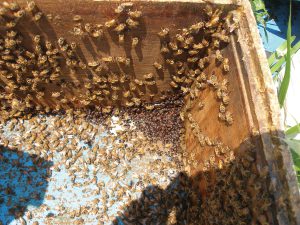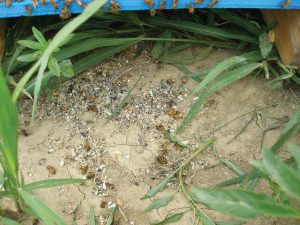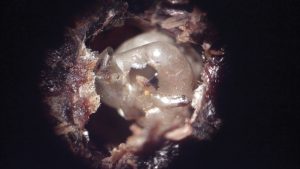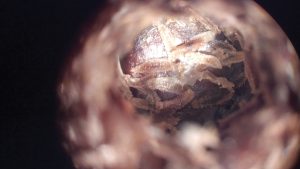Much of what you’ve heard is wrong.
By: Charles Linder
This is intended to question the way you look at small hive beetle. Most experts will tell you SHB don’t harm strong hives. Some have even claimed that only queenless or sick or unhygienic hives are susceptible.
None of this is new. A quick study will show you that Jamie Ellis has done some great work, and there’s a really nice paper from Clemson available online also. The only thing I add to the discussion is I believe the beetles are much more aggressive than usually mentioned. I found “The handbook of small hive beetle IPM” by Michael Hood. He also notes that at times the beetles will take over strong hives.

Lots of bees, but lots of beetles.
Small hive beetles (Aethina tumida) were found in the U.S. in 1996 and Australia in 2002. From the initial reports, they have been moving rapidly northwards. It seems cold weather is a small hindrance, soil types that allow the larva to pupate is the main requirement. They have made rapid progress spreading across the U.S. SHB tend to travel at night, and so far seem to use only beehives as a breeding area. The females lay eggs in the hive and three to eight days later hatch. The larva feed for a few days then drop to the ground to pupate. Adult females can lay up to 2000 eggs. Generally in clusters around the hive, but are also known to chew into the sides of capped cells and deposit eggs. (more on this later) The beetle larva normally matures in about 13 days, but has been reported to mature as fast as five days under good conditions.
SHB is fairly new in my area. I first noticed them around four years ago. Almost everything I read said the same thing, strong hives, full sun and no problems. Normal good practices and healthy hives and you would not have issues. Around 2010 I started seeing them. Little buggers hiding on inner covers and running. A quick squish or two and they are gone. Very few of them to start with and not every hive or yard. I bought some beetle traps but I decided they were more trouble than they were worth, as long as hives were strong, no worries is what the experts said.
The next season was a little worse. Not terrible mind you but a weak hive or two were what we call “slimed” that’s when beetle larva hatch in your supers and ruin the honey. It seems to be a combination of an excrement with a yeast that creates fermented honey. The bees avoid it. In those cases the bees were gone. Empty hives taken over I told myself the bees absconded, or were robbed out and the beetles moved it.
The next two years were a lot the same, an occasional hive wiped out, and beetles taken over, but not a lot of beetles in general. One or two in several hives, once in a while a weak hive with more than a dozen. Quick find and squash and try to get the hive back up to strength. Win a few lose a few. Most hives get inspected every two weeks. Strong ones supers added, weak ones inspected and tried to nurse up.
Then comes 2014, things changed. Late May freeze killed a lot of brood and weakened hives. Two yards in particular were having a lot of problems. If I remember correctly I lost seven hives in June. All were full of SHB larva but I racked the loss up to weak hives getting robbed out. Somehow several hives in kind of shady wet areas never seemed to bounce back.
Then comes the game changer. My pumpkin client calls and asks for more hives. His other bee supplier has called and has no bees (bad Winter and Spring I am told) so he needs another 30 hives. Well drat, that means moving honey hives into pumpkins. Normally a loosing situation, pumpkins don’t make honey. But I pick four pallets of strong doubles with supers, from the yards I lost hives in. It seemed smart, close out the yards that had few hives, and cut down my travel time. So right after the 4th of July I move double deeps out of honey yards and into pumpkin patches.

The first sign – dead bee larva on the ground.
One thing you need to know about early season pumpkin yards. The ground is clean. Little to no weeds and the pumpkins have not yet spread out. So its kind of like a hardwood floor. When I went back the next day to remove supers, I find a large amount of exoskeletons out in front of the pallets. Bright white larva skeletons show up real well on bare dirt. My mid runs thru the possibilities, Pesticides? Nay just got to the field. Capped larva was not yet exposed. Moving damage? Robbing? Ants? Quick rundown makes no sense. These are two or three deep hives with a good cupful of chewed empty exoskeletons. Some almost complete, others vivisected. But just the exoskeleton of the pupa. Normal activity at the hive entrance, thousands coming and going, no sick bees, guards on duty, some bees clustered. All looks good. Time to dig.
So I opened hives. And what I found was not good. Top supers were not terrible. A few beetles and some honey, lots of bees. But then the brood nest. The first hive I picked looked like a war zone, with little hand grenades going off. Open cells with pieces of bee larva hanging out, and SHB larva everywhere. Three or four frames of it. SHB larva not in the super, but in the brood nest. Center of the hive, and the bottom board, holly heck literally thousands of beetles somewhere around two cups of the buggers. Squash kill thousands at a time. Quick search shows the queen and plenty of bees. Clean up as best I can and close the hive to regroup. Infected frames to the freezer.
I check the other hives on the pallet and SHB problems but nothing like the first. The other pallets with problems showed the same issue, SHB in the brood nest! I think there were five that were heavily infected with SHB larva and beetles. All queen right and full of bees. Probably in the 40k plus count for bees. Defiantly not weak hives that I missed! All had some viable brood. This doesn’t match. So I head home to plan and study. About that time I recall a post on the net, it mentioned finding a lot of exoskeletons of pupa in hives taken over by SHB seemed odd at the time.
Looking and researching – ‘strong hives’ that’s all you need. But then I find two Scientific articles that make a lot of sense. The first is Jamie Ellis’ work that shows clearly that hives will abscond when beetle levels get high. He tested inserting beetles into nucs. I also find tidbits from Michael Hood and Jamie Ellis – one is a paper that shows that beetles will lay eggs in capped cells. All I had read so far showed beetles laid on the honey and strong populations policed the areas and clean up the eggs. According to this the SHB lay eggs all over and try to put them in areas the bees can’t reach. His work shows that a good percentage of them are not cleaned up. He also shows evidence the beetles will use the ovipositor to place the eggs thru the sides of capped cells. When these hatch they feed on larva! Up until now I had believed pollen to be the beetles preference. Turns out they don’t much care, pollen, (I suspect an egg in pollen is hard to find) honey and now larva. In fact the honey supers in these hives seem to be infected last!
One other little tidbit of data, which matched what I had observed. Apis Melifera will chase, harass, and corral adult SHB but will totally ignore the larva. This is in slight contrast to Africanized bees which reportedly also remove larva. I suspect that is the key to the beetle’s survival that is creating more problems for us. It’s also reported that Africanized bees open up capped worker cells which contain beetle larva, something I don’t think European bees are doing. It sure appears that European bees are less defensive in general. I suspect European bee’s lower number of guard bees and guards around the periphery allow more egress for SHB than other species.
Now I had some stronger suspicions. Eyes open I started looking closer. And sure enough close observation on hives with lots of beetles (more than eight to 10 a hive) shows larva starting in the pollen band and or brood and moving thru the brood nest. Hatched larva is ignored. They don’t slime the brood like the honey which to me confirms a chemical reaction from the SHB and honey. Adult beetles are still harassed. At some point the queen stops trying to lay brood and the bees retreat. They move up into the super or upper hive until the number of bees dwindles, and at some point most abscond, usually by that time it’s a very small number of bees left. I actually watched this happen in eight hives. Watching closely over a period of two weeks, close inspection of capped bee pupae showed severe problems. Many capped cells were full of beetle larva. Pulling a larva and cutting it open shows many SHB larva feeding. One I cut open had 16 in one cell. I have counted as many as 25 in one cell. The catch is, its not every cell so it can be hard to find. They are very hard to notice until its a huge problem. Note you can see 19 dead SHB larva. There were 26 total in that capped cell.
In retrospect, I realize that beetles have been successfully breeding in bee pupae all along. Just tiny numbers. A hive with three or four beetles may be dropping a 100 or so larva a week untouched by bees. If you assume say 10 SHB larva per bee pupa, that’s only 10 contaminated bee pupa in a hive! If they were not succeeding already, the older ones would soon be gone, and no one I have ever talked to has seen them disappear.
I think what we are missing is noticing a few pupae here and there that are literally being consumed by SHB. If the infected pupa is removed by the bees the SHB may be pupating from that point. If you look close you will see a few larva on the bottom boards, and one thing for sure SHB larva are extremely mobile. Moving 30-40 feet across a concrete floor is not uncommon.
Of course this makes me ponder the conventional wisdom and what’s changed? First off, I am not convinced it has changed. One thing to note is that SHB takeover happens quickly. Beetles hatch in three days. Most of us don’t do full inspections that often. Another factor that I ponder in retrospect, 2012, and 2013 were very dry years. Drought conditions for my area most of the year. This year was wet, very wet. And the hives with issues were on wet low ground, and shaded.

There were 26 Small Hive Beetle larva in this brood cell.
 What I suspect is this wet weather has allowed the larva to successfully pupate at a very high ratio, so small populations of beetles turned into large populations very quickly. Hives that were strong were not inspected real close, and the bees allowed the early season beetle larva to escape and pupate. Suddenly there is an invasion, exceeding an economic threshold. The beetles then lay in the brood nest and pollen band at a rate the bees cannot keep up with. And suddenly literally within a five day window the brood nest is totally destroyed. Total collapse is shortly following.
What I suspect is this wet weather has allowed the larva to successfully pupate at a very high ratio, so small populations of beetles turned into large populations very quickly. Hives that were strong were not inspected real close, and the bees allowed the early season beetle larva to escape and pupate. Suddenly there is an invasion, exceeding an economic threshold. The beetles then lay in the brood nest and pollen band at a rate the bees cannot keep up with. And suddenly literally within a five day window the brood nest is totally destroyed. Total collapse is shortly following.
What I am sure of is that SHB turn from parasite to predator when the conditions are right. And that is not just weak hives. What does this mean? Well in the end the only difference is Beekeeper attitude. Instead of ignoring them it’s time to start being active in prevention.
So what to do? First where did they come from? Hives moved in the area and Nucs seem to be the main sources. A.I. Root touted packages back in the day as a way to get clean bees. No disease from the comb. Still viable but I can promise you beetles get shaken into packages also. There is a product called the Beebus which is for packages designed to let SHB out of the cluster. Many suppliers are using them. I personally noticed them in packages, hiding behind the center bars and in the corners. Prevention of getting them in the first place is a good start. Typically packages that come from dry sandy soil also should be clean. Any nucs should be THOROUGHLY inspected.
Look closely at the soil conditions where you place hives. Dry soil in full sun will slow down beetle growth. Wet, damp shaded or irrigated soils, favor the beetles.
Treatment
After learning what I did, it was time to go on offense. Gardstar ground drench was used everywhere. Normally I shun pesticides, but this time was different. I needed to stop the larva. A few of oil trays were ordered and placed under the worst hives. 200 beetle barns were installed, at least two in each hive. I started with Checkmite. Coumaphos in the Checkmite seems to work very well, Beetle jails with vinegar in the middle section oil in the outsides also work, but can be a pain to handle.
This Winter I will be doing powder sugar treatments, not for mites, but for SHB. Put the hive on an oil tray and dust it. The sugar seems to agitate the bees into harassing the beetles more than usual. You will see a huge drop of beetles in the first five to 10 minutes.
Screened bottom boards are a thing of the past for me. I think it is too easy for that Larva to drop to the ground, I have also used this as another reason to switch to top entrances. The bottoms of my hives are pretty well sealed, in the hopes of stopping the larva from reaching the ground. Pollen patties must be watched closely, and beetles will successfully hatch and grow in division board feeders. I am currently testing on weather or not they escape the feeders to pupate or eventually drown.
I also notice in my area around September 1 the beetles stop laying eggs. Around the same time I noticed less harassment by the bees in general. Beetles moving around frames pretty much at will, little to no harassment. Not sure why, but I am sure there is less harassment than there was in the summer months. This allows the beetles to Winter well inside the cluster.
One key is don’t wait. Once you spot a beetle, be proactive, another note to consider, your location. Beetles need soft moist soil to pupate. Many areas of the country will never have issues. Most of the southwest will remain beetle free I suspect. Those in the southeast however know better. I suspect that is why hives in full sun don’t seem to get bothered as much.
I also suspect that weather will be an issue. Wet weather favors the beetles. Don’t think cold bothers them. Adults Winter in the cluster with the bees. Normally several of them in a cell I have found many in dead outs this way, and several small Spring cluster full of beetles, before any real pollen flows. For those of you without beetle problems, stay vigilant and thankful, but when those with problems tell you they lost a hive, don’t assume it was their beekeeping skills. Understand that at times it doesn’t matter, the beetles can and do take down good hives.






